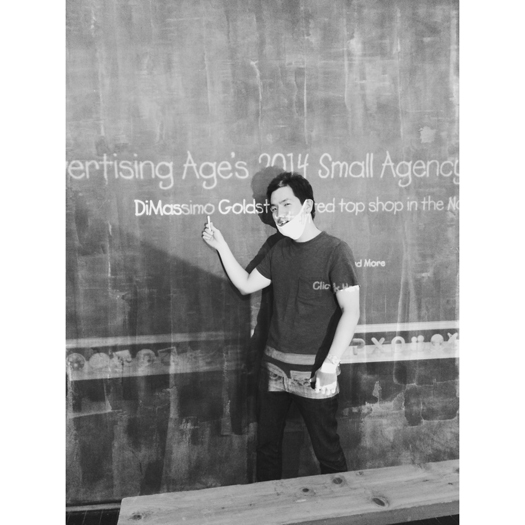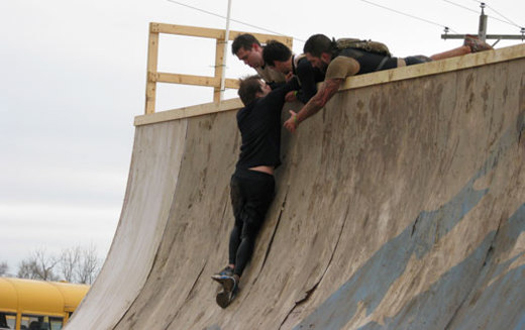By
Team DIGO | 08/01/2014 | in

Q Choi, Motion Graphics Designer at DiMassimo Goldstein
I was born and raised in Seoul, Korea. I graduated from business school there without aim and worked with no passion. I knew that it was not what I wanted, and decided to study graphic design in New York. I finally moved to NYC in 2009.
I didn’t expect to be working at an ad agency when I graduated from SVA. Now, it has been almost 2 years since I started working at DiGo.
Since I majored in motion graphics, I tried to get a job at post-production or broadcasting companies, and I thought I should. I had freelanced at several studios and broadcasting companies, and enjoyed experiencing the field. However, I needed to get a full-time position at some point due to my visa status. Fortunately, I got a chance to interview with Mark DiMassimo. And he gave me a great opportunity to start a motion graphics department at DiMassimo Goldstein.
Mark and the Creative Director allow me a lot of freedom to create motion graphic pieces — much more than I expected. In the past few years, we were awarded Best In Show at the Financial Communications Society Portfolio Awards, and Silver at New York City ADDY’s. And now, DiMassimo Goldstein was just honored with Small Agency of The Year, Northeast Region in 2014. I am so proud to be a part of all of these.
It’s not just our client work, but our internal projects motivate me a lot as well. We have created agency reels, party movies, chalk wall drawings and holiday videos. These inspire us and keep us fresh.
Additionally, It’s always fun to hang out with DIGO people and they actually help and encourage me a lot. I had a hard time to communicate and speak in English. Especially, I didn’t have the confidence to speak, and it is actually much harder for me to write this blog than designing or animating. These passionate and outgoing co-workers help me to speak more and make the happy hours happier.
DiGo allows me what I want to do and treats me like a family. We have been creating better projects this year, and I’m sure we are going to get more than we’ve achieved.
By
Team DIGO | 07/29/2014 | in
The Best Small Agency In The North East, According to AdAge. You.
Yup, that’s right. Sarah just reported from The AdAge Small Agency Awards in Austin that DiMassimo Goldstein has taken the GOLD for the North East region.
Take a look at a map or globe — that’s a pretty large parcel of real estate!!
This one is really about all of us. All of us together. And the clients too, sincerely. And the great leaders we have built and earned. But mostly the leadership that flows in every direction at our place, up and sideways, and ping pong-like too.
This really is about courage, love, and understanding.
And it really is a story of a leap to greatness.
Not that you should think I’m suggesting we’re there yet, though I don’t question AdAge’s judgement. For myself, I think we’re in mid-leap and we still need all of those values — every bit of them that we can muster — to get where we’re going.
But, we’ll take this encouragement. We’ll celebrate. And we’ll use it too!
I’m proud of you.
Mark
By
Team DIGO | 07/16/2014 | in

Kevin Karp, Associate Creative Director/Art Director at DiMassimo Goldstein
“Alright, what do you want to do?”
I’d spent the last nine months trying to answer the question for myself. Now, the creative director at DiMassimo Goldstein was asking me the same, while clicking through my website half-heartedly. Considering the lack of advertising in my book, it was a fair question.
In the months after my start-up company crumbled, I’d lost a lot: confidence, purpose, direction, and most of the progress I’d made as a self-supporting, high-functioning adult. I hadn’t touched my design portfolio since the first term of the George W. administration, and the only reason I had a meeting with him at all was because he owed a favor to a recruiter. And he was desperate. (more…)
By
Team DIGO | 07/10/2014 | in

Richard Roberts, Business Development Executive at DiMassimo Goldstein
Zero. That was how much experience I had with advertising before walking through the doors of DiMassimo Goldstein back in April 2013. As a matter of fact, it the was first time I saw the inside of an ad agency other than while watching Mad Men, even though I was already a self-proclaimed Don Draper (could also be the hair or love of skinny ties).
I was interviewing for an “Account Executive” position, but hell, I would have interviewed for a position digging ditches for DiGo, if that’s what it took to get into this industry and more so with this company. The reason I was so adamant about getting into advertising is a story for another blog, but long blog short, I got an offer despite my lack of experience. My lack of experience began to show quickly, and the agency was changing just as fast. A few months later it looked like I was going to be walking out of those glass doors (which I think might look better with ‘Roberts’ added to them as well, just saying) for the last time… a short ride that started after a year of incessant emailing to Mark DiMassimo. (more…)
By
Team DIGO | 06/26/2014 | in
How do you escape the shadow of an e-commerce colossus and find your company’s voice? We look at examples from Uncommon Goods, Hallmark Design Collection, UGMONK, Noon Style, Villy Custom, Very Pink, Think Geek and Betabrand to learn how the lowest price is not the only consideration when buying online.
By
Team DIGO | 06/13/2014 | in

Kevin Still, ACD/Writer at DiMassimo Goldstein
I never wanted to live in New York City, frankly the idea sent chills down my spine so cold it froze my southern roots. All I heard growing up was how rude New Yorker’s were because they got mugged every single day. Plus, where do you even get real sweet tea in New York anyhow?
So, when I received an email from an old instructor and DiMassimo Goldstein creative director about visiting and checking out the opportunity to become a copywriter here, I thought, “Eh it’s a free trip to NYC, but working and living there? Not a Slurpee’s chance Hawaii.”
I have to say, no matter where you’re from; flying over the NYC skyline is breathtaking. You can see and feel the energy, even from the plane. And for the first time in my life, I was greeted at the airport with a driver dude holding up my name on a sign. I felt like kind of a big deal.
When I walked into DiMassimo Goldstein I could feel the energy. The air was electrified with creative excitement, bursting from a sleek and strikingly designed office. Complimented by the ultimate cherry on top: a Ping-Pong table! The next couple of hours were kind of a blur; I met with my potential partner (also named Kevin) and other amazingly creative and extremely talented people. (more…)
By
Team DIGO | 06/10/2014 | in

Photo by Merfam
The Inspiration
When Will Dean graduated from Harvard Business School, he faced a choice between helping the British Government catch terrorists or pursuing his dream – one that HBS called “too ambitious” when his business plan made the semifinals of the Harvard Business School New Venture Competition. Dean had soured on the corporate business world, and was in a mountain of debt upon graduating business school. He decided to focus on a building a lean startup, spending $300 on a basic website, $20 on Facebook ads and then worked hard to generate buzz for what would become the first Tough Mudder event.
The Leap to Greatness
The inspiration for Tough Mudder was the insight that, for athletes, the marathon experience can be quite dull. With over 500,000 people participating in marathons and 1.4 million attempting half marathons, the founders saw room to disrupt what were often poorly-run events with suboptimal experiences. As opposed to an individual event, they focused on teamwork. The result was a challenge that features a 10-12 mile course packed with 25 obstacles designed by British Special Forces to test the participant’s all-around strength, stamina, mental grit and camaraderie. (more…)
By
Team DIGO | 06/06/2014 | in
One secret of managing for growth is simply refusing to get clogged up.
You can think of this as never letting anything sit on your to do list.
But there’s still a problem:
Some of the most important things never make it to your to do list, because you don’t know what to do about them.
That’s why you need to start off by making a Worry List. What works for you? Talking? Doodling? Taking a walk? For me, writing works best. I’m uninhibited when I write. I just let my fingers fly and write any bullshit that comes out through my fingers. No one needs to see it anyway. At some point, I ask myself how I am. I ask myself what I’m worried about. I brainstorm concerns. There’s no bad worry here. I typically learn things I already knew, but didn’t know or remember I knew.
Think of great management as efficiently moving things from your worry list to your to do list to delegated, done or do-not-do.
I’m here to help you clear the blockages. The whole agency is. That’s what it’s an agent for! (more…)






